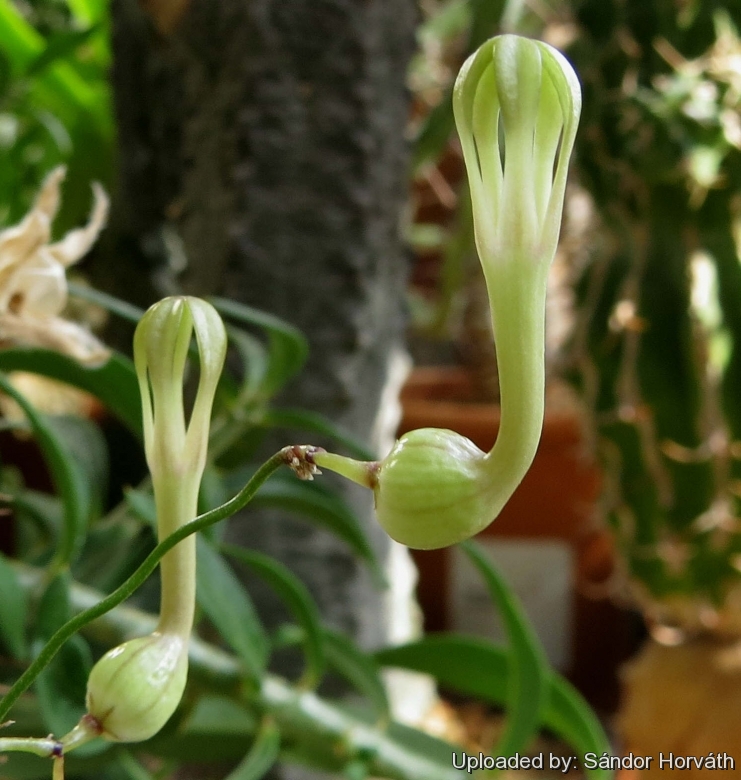




Your support is critical to our success.
Kew Bull. 53(4): 949. 1998 [23 Dec 1998]
Family: ASCLEPIADACEAE

Origin and Habitat: Ethiopia, Kenya, northern Tanzania.
Type Locality: Coast Province, Taita-Taveta Distr., Mt. Kasigau, along water pipeline path on southern side from Makwasinyi village, 03 49 S, 38 41 E, 900m.
Altitude range: 50-1860 metres above sea level.
Habitat and ecology. Ceropegia inornataSN|32224]]SN|32224]] is a low herbaceous climbers in coastal forests and wooded bushland and thickets of uplands plateaux. The flowers are usually produced in shady hidden places and are well adapted for fly pollination. The pollinators are small, mostly female dipteran flies, c. 2.5 mm long, which carry pollinaria on their proboscis.
Synonyms:
- Ceropegia inornata P.R.O.Bally ex Masinde
Description: Ceropegia inornataSN|32224]]SN|32224]] is a fairly vigorous and floriferous twining perennial herb characterised by a tuberous rootstock, and a greenish inconspicuously coloured corolla with glabrous lobe margins. Stems occasionally branch at the nodes and can grow up to 2 mm thick and 2 metres and more in length. The leaves are succulent up to 6 cm long. The peculiar flask-shaped flowers, with segments joined at their tips to form a cage-like structure are greenish-white, the tube is curved, with a balloon-like inflation at the base. The corolla tube and segments are variable in the size (usually about 3,5 cm long).
Rootstock (caudex): Tuberous, depressed-globose, 7-18 (-30) tall, 18-25 (-80) mm in diameter, smooth, creamy white, turning light brown when mature, often noticeably sunken at top. The main tuber is often contented by rhizomes to smaller secondary tubers.
Roots. Fibrous from above and below the tuber.
Stems: to 2 m, herbaceous, sparsely branched, 1 - 2 mm in diameter, wiry, glabrous or hairy, nodes often swollen to form globose stem tubers. Internodes 0.6-25 cm long.
Leaves: Opposite, characterised by a tuberous rootstock, and a greenish or purplish inconspicuously coloured corolla with glabrous lobe margins., lamina 2 - 6 long, 0.5 - 23 (-4) cm broad, variable in shape from cordate to elliptic-ovate, acuminate, apiculate, basally somewhat rounded, glabrous or whitish-pubescent, petiole 2. 6 long, 0.5-1.25 mm in diameter.
Inflorescence: Pseudo-umbellate, with up to 4 flowers simultaneously open at a time. peduncle 2-9 mm, glabrous, annual. Pedicels 2-15 mm long. Sepals 0.5-2.5 mm long. Corolla 15-32 mm long, greenish or greenish-yellow / purple. Corolla inflation globular, 4-9 in diameter. Corolla-tube narrowing above the inflation, 1-2.5 mm in diameter, then widening to 2-5 mm, outside glabrous, inside with a few white hairs at the base. Lobes linear, 10-13 mm long, apically connate to form an ellipsoid cage-like structure. Corona white, cup-shaped.
Fruits (follicles:) Light green, streaked with maroon 7-16 cm long, 2-3 mm in diameter. The follicles are usually in pairs, but very often only one of them develops and the other is aborted. Each follicle contains numerous seeds and as the fruit bursts open when it dries out, the seeds are dispersed by floating on the wind with their tufts of silky white hairs.
Seeds: 6 mm long, 15 mm wide, brown, coma (tuft of hairs) 25-40 mm long.
Bibliography: Major references and further lectures
1) Focke Albers, Ulrich Meve “Illustrated Handbook of Succulent Plants: Asclepiadaceae: Asclepiadaceae”, Volume 4 Springer Science & Business Media, 2002
2) “Flora of Ethiopia: Canellaceae to Euphorbiaceae” National Herbarium, Biology Department, Science Faculty, Addis Ababa University, 2003
3) Patrick Siro Masinde “Ceropiegia inornata (Asclepiadaceae), a new species in Kenya and Ethiopia.” Kew Bulletin Vol. 53 (4): 949-954. 1998
4) Patrick Siro Masinde “Trap-flower fly pollination in East African Ceropegia L. (Apocynaceae)” International Journal of Tropical Insect Science / Volume 24 / Issue 01 / March 2004, pp 55-72, Published online: 28 February 2007
Cultivation and Propagation: Ceropegia inornataSN|32224]]SN|32224]] grows best in tropical or subtropical climates. It is seldom cultivated and is grown mainly by collectors used an ornamental vine and makes also a good room plant. It is best used as a container plant under roofed patios (lapas), on verandas, balconies of flats or any other place in and around the house where space is restricted. Unfortunately, despite their beauty, the flowers do produce an unpleasant scent, which attracts flies acting as pollination agents. The strength of the scent is very variable and in some plants it is undetected by the human nose.
Exposure: It need partial shade or filtered sun. Shade is sometimes provided in hot climates.
Substratum: The plants like a rich, porous, well-drained soil mix, with extra leaf mould added but aren't usually too picky as to soil type.
Watering: During the growing season, the plants are watered on a regular basis, making sure that they never dry out completely with an occasional spray over the foliage. In late August, water is restricted to about once a week until January. Night temperatures at this time should be about 10° C. In January or February, watering is stopped for a period of 4 weeks. In March, regular watering is resumed.
Fertilization: They are fertilized on a monthly basis with a balanced fertilizer during active growing phase.
Hardiness: Will tolerate temperatures to 45° C, but prolonged cold will damage or kill the plant.
Propagation: In its natural environment, root development of Ceropegia inornataSN|32224]]SN|32224]] is stimulated when the nodes touch the soil. The plant is thus easily grown from cuttings. Make sure the cutting contains a few nodes, let it dry out for a few days after which it can be planted. If available, plants can also be easily grown from seed.
| Your Actions | |
|---|---|
| Back to Ceropegia index | |
| Back to Asclepiadaceae index | |
 |
Back to Succulents Encyclopedia index |
Privacy stantement - Terms and conditions - How to cite - About us - Feedback - Donate




